OPPENHEIMER (2023)
The story of American scientist J. Robert Oppenheimer and his role in the development of the atomic bomb.
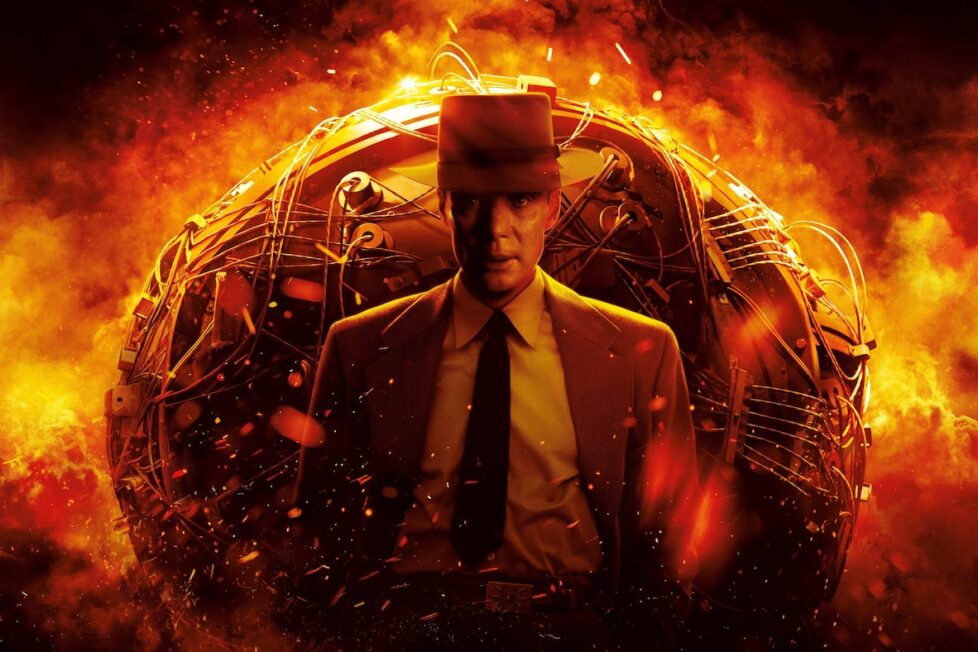
The story of American scientist J. Robert Oppenheimer and his role in the development of the atomic bomb.


Attending a funeral in the mid-1980s, I briefly met a retired US colonel who had been present at the first detonation of the atomic bomb, on the Trinity test site in the New Mexico desert on 16 July 1945. I doubt the colonel ever thought of me again, just one of many strangers at his daughter’s funeral (all his children, born after that epochal event, had died of cancer before their fortieth birthdays), but I have always treasured that tiny connection to one of the most significant moments of the 20th-century, which could still (if we’re unlucky) turn out to have been the most fateful in human history.
The explosion at Trinity was only a moment: one from so many millions in the colonel’s life. But in all honesty, I think of him entirely through the lens of that test, never considering whatever else he might have done or been. And this way that an event can completely overshadow an individual is perhaps the reason that there has never been a truly satisfactory portrayal in film or television of J. Robert Oppenheimer, sometimes known as “the father of the atomic bomb”. It is almost impossible to separate the man from the achievement; it would be like making a movie about Christopher Columbus and ignoring the New World.
This intractable problem pervades Christopher Nolan’s Oppenheimer as much as any of its predecessors on the subject. Certainly, it’s better than any of them (though that isn’t saying much), and a powerful and memorable film in its own right. But it’s far too flawed to be regarded as Nolan’s masterpiece or definitive on its subject.
In this it falls short of the 2005 book on which it’s based, American Prometheus: The Triumph and Tragedy of J. Robert Oppenheimer by Kai Bird and Martin J. Sherwin, which (although some consider it too sympathetic to its subject) is regarded as the authoritative biography of the man in the same way 1987’s The Making of the Atomic Bomb, by Richard Rhodes, is seen as the authoritative history of the project itself. And in some ways, Nolan’s film falls awkwardly between the different perspectives of the two books, purporting to be a biographical portrait of Oppenheimer himself but frequently digressing into details of the project that don’t really illuminate the man. It wants to build a mythic picture of Oppenheimer but, while he’s almost constantly present, the movie never gets nearly far enough inside him to do that.
True, it is ultimately about Oppenheimer rather than the bomb, and for the most part, it is Oppenheimer’s subjective reality that Nolan gives the audience. Thus we don’t, for example, see the actual bombing of Hiroshima and Nagasaki, because Oppenheimer was six thousand miles away; and the Red Scare of the postwar period is portrayed almost entirely in terms of how it affects Oppenheimer, with little reference to its much broader context. Yet Nolan frequently can’t resist throwing in nuggets of detail about the Manhattan Project (the over-arching programme to develop the bomb, of which Oppenheimer directed the design laboratory) that add nothing to our picture of the man himself.
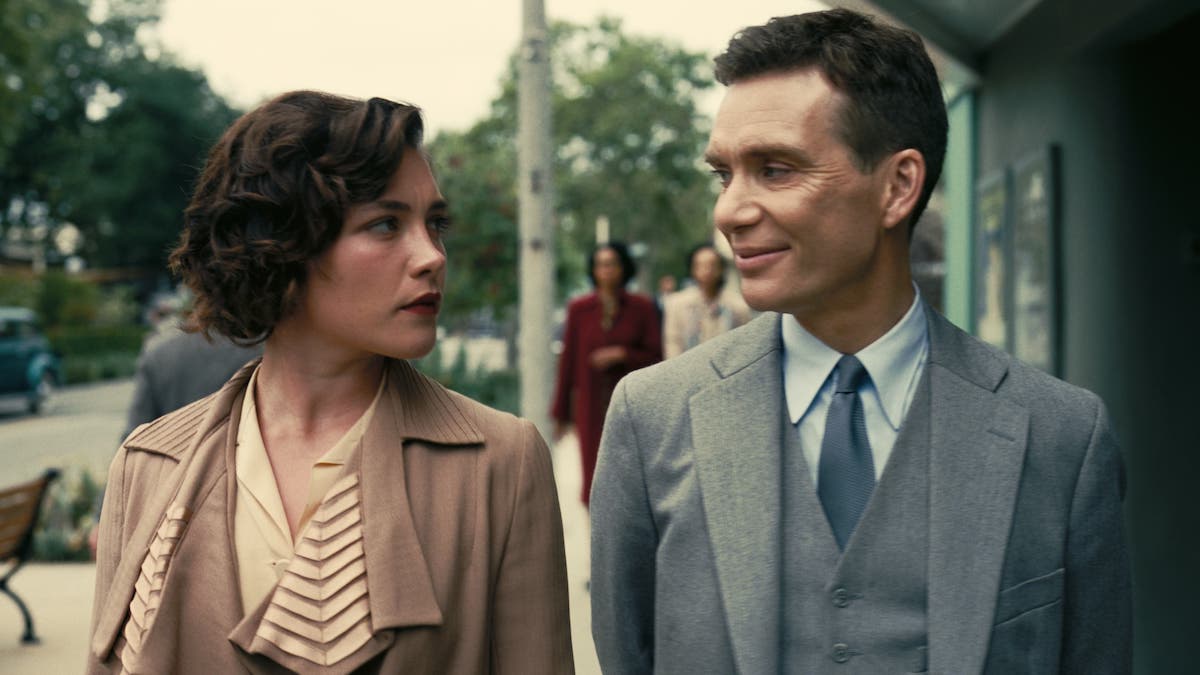
For example, the question of whether to use the “gun” or “implosion” methods to kick off a nuclear chain reaction was a crucial one for the scientists he led at the Los Alamos Laboratory in New Mexico (and both technologies were used in the two bombs dropped on Japan in 1945). Any account of the bomb’s development would justifiably take time with it, yet it’s barely relevant to understanding Oppenheimer’s character, his political views, and so on. Nolan seems uncertain here, unwilling to simply ignore it as a technical detail, yet equally unwilling to move away from his human subject for long. The result is that the issue is raised, but only for a few seconds, pointlessly.
More time is given to some of the less abstruse and more philosophical questions raised by the Manhattan Project. The film rehearses the major arguments accurately enough—in the short term, the bomb would kill enormous numbers of Japanese civilians, but save the potentially greater cost in lives of an American invasion of Japan; in the longer term, it might prevent future wars by making war unthinkable, but it might also initiate a race toward ever more horrific weapons. And Oppenheimer also does a useful service, 80 years later, in clarifying to those unfamiliar with the history that, far from forging ahead blindly, the scientists were well aware of the implications of what they were doing and frequently uncomfortable with them. (Indeed, if you read contemporary newspaper accounts of Hiroshima, the most startling thing is just how quickly the ramifications of this weapon were also understood by those who had known nothing of its development.)
Still, in Nolan’s movie, all this is ultimately just a backdrop for Oppenheimer the man. In a film full of contradictions, one of the bigger is the way there are so many people, events, and issues that they run the risk of sidelining the protagonist…. and yet you never get the feeling they truly matter, as they’re just the context through which J. Robert Oppenheimer moves.
So, this is a ‘Great Man’ approach to history, and like all movies which come from that perspective, Oppenheimer runs the risk of overstating its case. It comes perilously close to presenting Oppenheimer as a kind of Alan Turing tragic-genius figure, single-handedly winning the war before being persecuted by an ungrateful nation; but, to be fair, Nolan doesn’t fall into this trap so far that he can’t get out, although he goes further in this sanctifying direction than previous movies have.
That kind of overstatement isn’t uncommon in biographical films, of course. (Nolan has made the hyperbolic claim that Oppenheimer was “the most important person who ever lived”, but he’s in good company with such a sweeping statement because Winston Churchill, at the time, called the project “out of all relation to anything else that exists in the world”.) It’s a particular pitfall in a film about Oppenheimer, though, precisely because at the Manhattan Project he was not what he started out as (and initially looks like being in the movie): a brilliant young physicist.
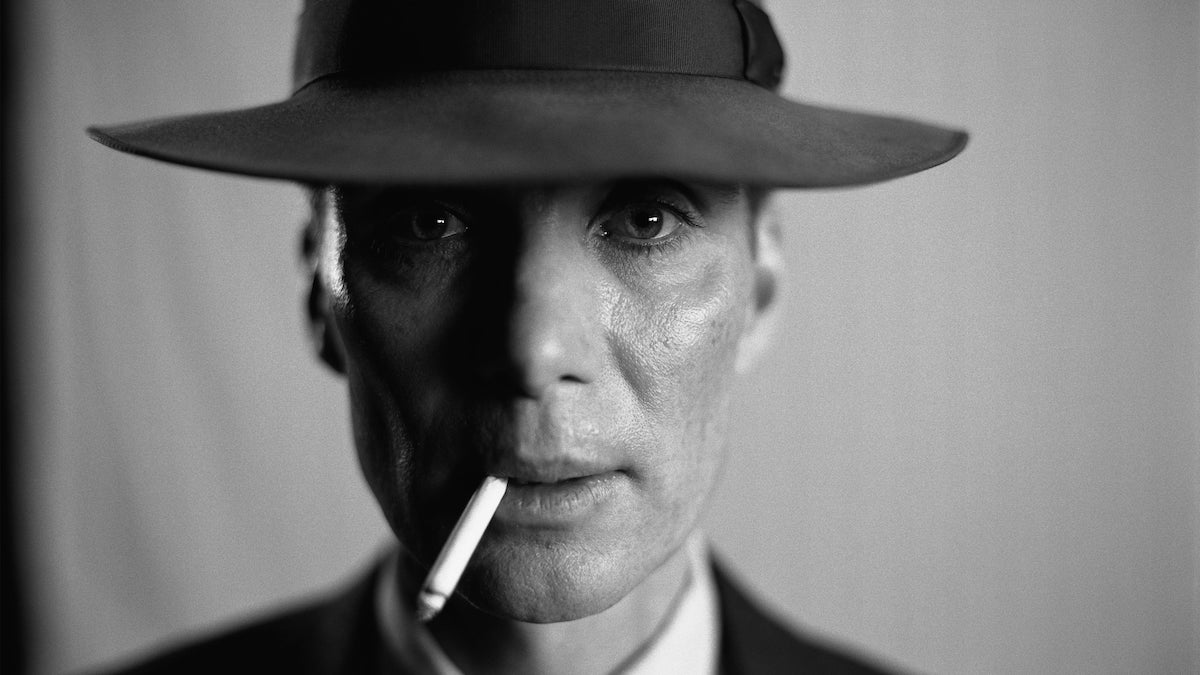
Clearly, he was no slouch in the lab, but his real genius was as a project manager and a motivator of people rather than as a scientist, coordinating the enormous process of designing and building the first real weapon of mass destruction. He should more accurately be called the midwife of the atomic bomb, rather than the father. What was done at Los Alamos was a team effort if ever there was one (thousands worked there), and while Nolan’s Oppenheimer does try to bring this across with its large cast of scientists, by nearly always reducing them to vignettes it can still give the impression of the lone visionary among lesser men.
This happens largely by omission, through the way that the others are only ever seen as secondary figures to Oppenheimer, though there’s one notable scene where Nolan’s tendency to elevate Oppenheimer above the rest is very visible. Shortly after the bomb has been completed, Oppenheimer addresses some of his team on a basketball court, and here Oppenheimer seems to contrast his inner doubts (conveyed through flashes of imagined nuclear-holocaust horror) with a mindless gung-ho attitude from his cheering audience. The real message of the scene should be that both Oppenheimer and the others were simultaneously triumphant about successfully completing their project and concerned about what it meant; the superficial takeaway, though, is that only Oppenheimer sees what the others can’t.
There is a less stereotypical and more unusual tale to be told about Oppenheimer than the Great Man one, and it lies in the unlikelihood of his story. Not quite in the top league of scientists (“Oppenheimer’s achievements as a theoretical physicist never reached the level his brilliance seemed to promise”, wrote Rhodes), inexperienced in management, not thought of by his colleagues as a natural leader, a bon vivant uninterested in politics and current affairs for much of his early life, he nevertheless became an extremely capable head of the biggest (and most expensive) scientific project the world had ever seen, and one who (like many of the atomic scientists) was both thoughtful and outspoken on the implications of its work. Nolan’s movie (partly because of its complicated timelines, more of which below) fails to quite capture this transformation in Oppenheimer; instead, he seems predestined for greatness from the beginning, although of course that’s not easy to overcome in a film which would never have been made if he hadn’t got there.
Similarly, there’s a more complex story to be told about Oppenheimer’s later persecution by the FBI, Atomic Energy Commission chairman Lewis Strauss (Robert Downey Jr.), and others keen to see (or pretend to see) Reds under every bed amid the febrile anti-Communism of early-1950s America. Nolan seems tempted to give us Oppenheimer-the-martyr but the reality is muddier; though he was a victim of McCarthyism to a limited extent, he was hardly cancelled. He remained a prominent figure, still celebrated in many circles, and less than a decade later was publicly rehabilitated with an award from President Johnson. Moreover, if he was a victim of a witch-hunt he was hardly an innocent one: he was happy to supply the names of colleagues as Communists, for example.
This less attractive side of Oppenheimer gets little exposure in Nolan’s film, though Cillian Murphy does suggest some of it with his performance in the title role; he doesn’t make it too overt but he unmistakably suggests that Oppenheimer was a man for whom goals could take precedence over people. Rhodes writes of his “casual cruelty, born certainly of insecurity”, for example toward women and toward anyone he considered to have a lesser mind, and suggests that “the charismatic hubris that was his glory… was also the flaw that brought him low.”

In one small but telling scene, the movie does bring that home well. Oppenheimer, after being told the Los Alamos scientists will have to become military officers, promptly orders a uniform–seemingly the only one of the scientists to do so—and evidently admires himself in it. The incident is true (though the film doesn’t mention that Oppenheimer also failed the Army’s physical test, which would add a further level of irony), and this is the hubris that Rhodes refers to in action.
But for the most part, Oppenheimer presents it merely as confidence, and while the movie doesn’t introduce any outrageous historical distortions, it often implicitly plays up its main character’s part in events while playing down others. For example, it was the meteorologist Jack Hubbard, not Oppenheimer (as in the film), who accurately predicted a storm the night before the test would pass; it’s a tiny point in itself, but the way that Nolan insists on giving Oppenheimer’s familiarity with New Mexico an almost mystical quality is typical of the film. Similarly, international control of the bomb was more the idea of Niels Bohr (Kenneth Branagh in one of the film’s many blink-and-you’ll-miss-it star cameos) than of Oppenheimer. And so on.
As with so many of Nolan’s films, Oppenheimer is built around a complex structure of timelines that are easier to follow in practice than they may sound on paper. The first, in chronological terms, concerns Oppenheimer’s early adult life as a student at Cambridge and Göttingen (before the Nazi’s ascent to power) and then the beginnings of an academic career in California. This is a relatively minor strand, but the second timeline is central for much of the film though always with excerpts of others interspersed. It covers his Manhattan Project tenure from 1942—when the Americans, only recently having entered World War II, started to take it more seriously and move from theory to practice—until the end of the war.
A third timeline, which in a very different way (mostly confined to a single room) provides as much drama as the Manhattan Project one and dominates much of the movie’s second half, concerns a hearing in 1954 when Oppenheimer appealed the removal of his security clearance after suspicions of Communist affiliations. Related to this, a fourth timeline is then set in 1959, when Oppenheimer’s nemesis Strauss is narrowly rejected by the Senate in his bid to become secretary of commerce, a snub which scuppered his career.
The core of the film, though, lies in the wartime Los Alamos and 1954 security clearance hearing strands; the downfall of Strauss a few years later might be dramatically necessary to balance the apparent downfall of Oppenheimer, but tells us little about Oppenheimer himself.
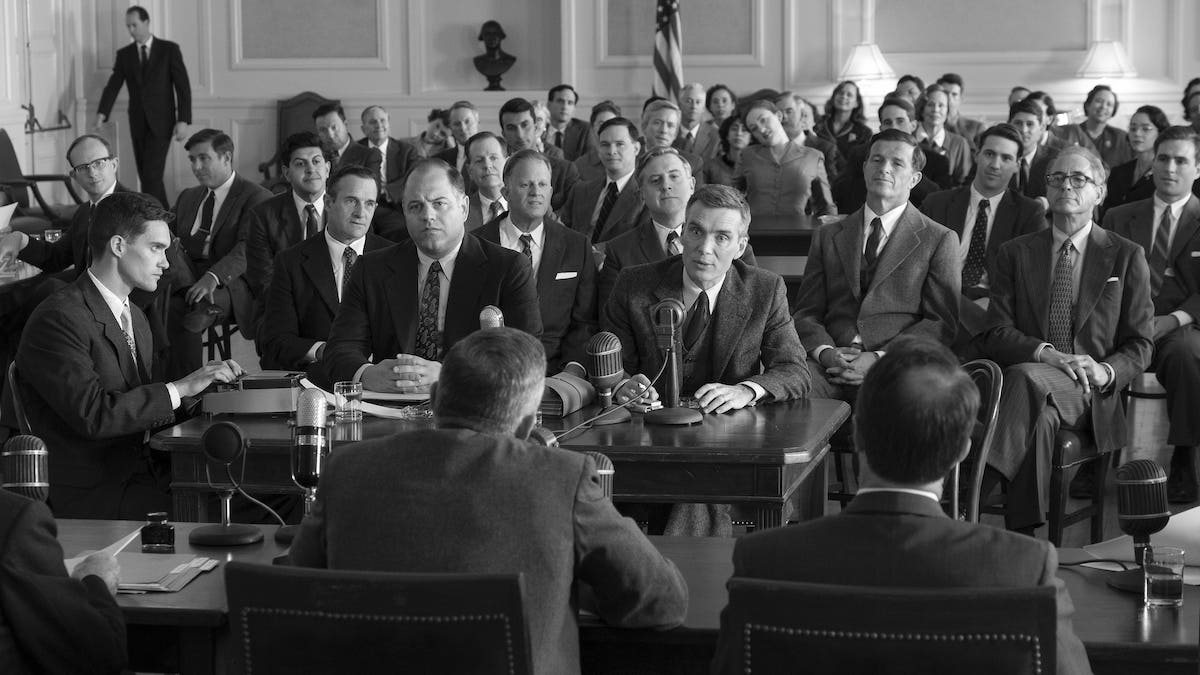
A few scenes are set in other periods—like a 1947 episode where Oppenheimer first comes to work for Strauss, before the latter turned against him—but they’re comparatively short and of minor importance. So is the section on Oppenheimer’s early life, which arguably adds even less: it’s too concerned with hastily force-feeding us biographical highlights rather than developing any particular character or situation. A montage where Oppenheimer admires a painting by Picasso, reads Eliot’s The Waste Land, and so on, is a typical (and somewhat crude) attempt to make a point about his cultural sophistication as quickly as possible.
Nolan’s screenplay isn’t free from didacticism, then, even while it often gives topics so little time it would’ve been better off not picking them up at all and concentrating on the personality of Oppenheimer rather than the minutiae of mid-century physics (for example). But for all its deeply-rooted problems there are some exceptional sequences and, particularly, performances—as well as an atmosphere quite unlike that of most biopics or historical films, partly thanks to the slight drifts away from reality (very Nolanesque).
It would be wrong to say that Oppenheimer is dreamlike because, for the most part, it’s doggedly realistic. Nevertheless, from the opening moments with Oppenheimer mesmerised by drops of water falling into a puddle (like bombs? or like actions creating consequences?)—which becomes a recurrent motif—there’s a pervasive sense more is going on than meets the eye, something huge is just out of sight, which despite the crowded cast of real-life characters and the ticking of factual boxes does give the film a somewhat philosophical quality too.
In the young Oppenheimer’s mind that huge something might have been the quantum world, suggested by Nolan with rather Malickian near-abstract imagery, but for the film the ever-present idea is the bomb itself; in a sense, everything in Oppenheimer either leads up to the test of 16 July 1945 or comes as a direct consequence of it. Nolan’s use of multiple timelines (a favoured technique since his first film, 1998’s moody London thriller Following) tends to accentuate this feeling the film is constantly circling around a single thing; he’s argued that we don’t normally receive information in strict chronological order, fiction being the exception rather the rule, and indeed breaking from it suits a biographical film well.
The bomb’s detonation is, naturally, the mother of all money shots in any film on this subject, and Nolan handles it with assurance (and sans CGI), extracting maximum tension from the countdown with the aid of Ludwig Göransson’s deafening score, and then—characteristic Nolan again—stretching the time between the white light and the arrival of the boom and the shockwave, depicting it subjectively rather than with literal accuracy.

If the drama fizzles a bit after this…. perhaps it’s inevitable. It’s also true that the more-or-less authentic locations of the pre-bomb timeline (New Mexico, Berkeley, Princeton) and the detailed world-building in them are more engaging, and make more use of IMAX, than the much more constrained settings of the 1950s timelines. Still, even there Nolan does what he can to add visual interest—for instance, through occasional hallucinations (Oppenheimer finding himself naked before the clearance committee) and by alternating colour with the attention-grabbing high-contrast black-and-white of his regular cinematographer Hoyte van Hoytema.
Göransson’s insistent, propulsive score often—though not always— supports the narrative well, too. Nolan seems to like a rather immersive approach to music and Göransson (who composed for his 2020 sci-fi Tenet) provides that, although sometimes excessively. His accompaniment to Oppenheimer is so loud it sometimes drowns dialogue and draws too much attention to itself. At other points, though, even this can work—particularly in the run-up to the Trinity test, where the music’s urgency (complete with a clock-like ticking) parallels the scientist’s countdown—while quieter violin solos, very different in mood and sounding out-of-tune though in fact deliberately microtonal, are also effective.
The best thing of all in Oppenheimer, though, is the cast. Not the casting, which leans far too heavily and distractingly on familiar faces (why on earth bother putting Academy Award-winner Rami Malek in such a tiny role, for example?), but the way that even when their screen time is limited, virtually every actor does something distinctive and memorable with their character.
The emaciated, hyper-intense Murphy not only looks the part of Oppenheimer, but he is also much less bland than those who’ve portrayed the man before. And he communicates the sense of a man perpetually driven—and if it’s not fully clear to the audience what is driving him, to be fair it possibly isn’t even clear to Oppenheimer himself. This is consistently the mood of Murphy’s performance, but within it also manages to calibrate the character at different stages of his life: the uncertain student, the confident leader at Los Alamos, the stressed and haunted postwar Oppenheimer reflecting on his own past and his creation, and so on.
Equally impressive in a different way, and (as in other films about Oppenheimer) more entertaining, is a magnificent Matt Damon as General Leslie R. Groves, the officer charged with overseeing the entire Manhattan Project. Groves was fresh from building the Pentagon and could—in an administrative, not a scientific sense—equally well be called the father of the bomb. Damon has stronger competition than Murphy from previous cinematic incarnations: Paul Newman, despite much less physical resemblance to Groves than the jowly Damon, was far and away the highlight of Fat Man and Little Boy (1989), a.k.a. Shadow Makers, while the glowering Brian Dennehy also stood out from the made-for-TV CBS docudrama Day One (1989).

Damon’s Groves is a grumpy man (“I don’t take anything on trust”) but straight-talking, very sharp, and very decisive; when he eventually warms, just a little, to Oppenheimer it’s completely credible and the trace of a smile speaks volumes. Many of the key scenes between Oppenheimer and Groves benefit as much from Damon’s stolidity as from the more highly-strung Murphy. For example, their discussion of the possibility that the bomb test might ignite the entire atmosphere (a nearly zero chance, says Oppenheimer, but Groves would clearly prefer absolute zero).
And Damon has one of the most significant lines in the movie, too, delivered very casually: after his work on the bomb is done, Oppenheimer is preparing to move on to other things, and asks Groves to keep him informed on nuclear matters. “Of course,” says the general, “…as best I can.” And it’s immediately obvious from that qualification that Oppenheimer, no longer essential to the war effort, is going to be edged out into the cold. (And in reality, Groves would be, too.)
Many others in Oppenheimer’s large cast create impressively credible and human characters despite the limited scope of their small roles. Robert Downey Jr. as Strauss (one of the bigger parts) is outstanding among them, especially given that he’s mostly confined to rather static scenes and doesn’t participate in many of the obvious dramatic highlights: his Strauss is astute, measured, cautious, and visibly never quite comfortable, a self-made man who can’t quite conceal the chip on his shoulder.
Another stand-out is Gary Oldman’s President Truman, an actor much praised for his single and pointed line “Hiroshima isn’t about you” to a guilt-wracked Oppenheimer. Rightly, even if Nolan’s film doesn’t see it that way. (Oldman also played Churchill in 2017’s Darkest Hour, so presumably Stalin is next on his list?)
Some of the many other fine performances, in no particular order, come from Benny Safdie as a passionate Edward Teller, the colleague who later became obsessed with developing ever more powerful nuclear weapons; Tom Conti as Albert Einstein, not overdoing the dishevelled brilliance; Dylan Arnold as Oppenheimer’s brother; Josh Hartnett as the physicist Ernest Lawrence, looking the part quite well; Jefferson Hall as Oppenheimer’s Berkeley friend Haakon Chevalier, who unwittingly contributes to his downfall; David Krumholtz as the physicist Isidor Rabi; Dane DeHaan as a cold, even fanatical young aide of Groves who dislikes Oppenheimer; Matthias Schweighöfer as a friendly, slightly supercilious Werner Heisenberg; Macon Blair as Lloyd Garrison, Oppenheimer’s fussy but forceful lawyer at the clearance hearing; and Jason Clarke as Roger Robb, the Atomic Energy Commission lawyer who leads Oppenheimer’s interrogation at that hearing.
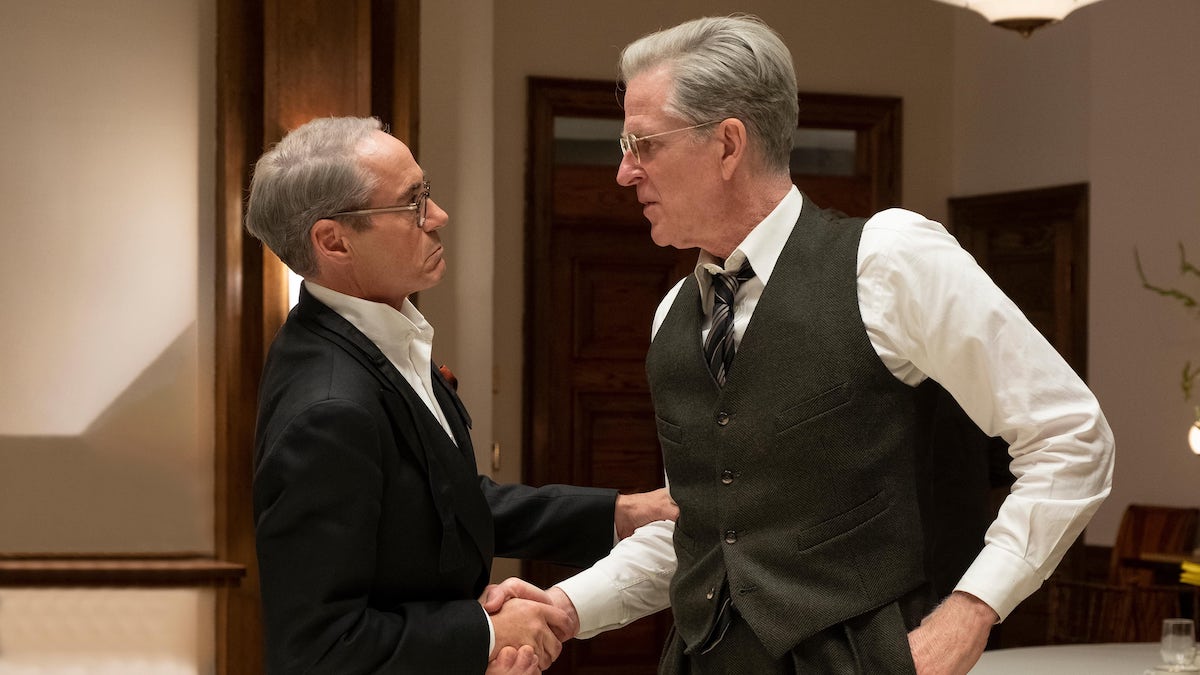
The film, like many of Nolan’s, has attracted criticism for its treatment of women, and there’s some validity to this. Like so much in Oppenheimer, Emily Blunt as Oppenheimer’s wife Kitty and Florence Pugh as Jean Tatlock (with whom he had a long affair) seem to be there as token nods to the facts, and though Blunt is strong in one scene where she’s questioned at the clearance hearings, the movie would lose little if both disappeared entirely. On the other hand, that’s true of a great deal in a movie which tries to cram in so much, so maybe it shouldn’t be seen as specifically a gender issue.
Given the scale of its ambitions—even the unrealised ones—other movies and TV depictions of Oppenheimer’s story pale beside Nolan’s, despite all of its shortcomings. Probably the best-known is Roland Joffé’s Fat Man and Little Boy, but though it is much more conventional in style than Nolan’s movie it suffers from similar issues, trying to fit in so many ideas and incidents that it comes across as choppy. Newman is great as Groves, but Dwight Schultz’s Oppenheimer is a non-entity, and a soulful romance between John Cusack (playing a fictionalised Los Alamos scientist) and Laura Dern dilutes the intensity of the race to build the bomb.
More interesting, in some ways, is the extremely early account of Los Alamos in The Beginning or the End (1947), directed by the prolific Norman Taurog and partly written by Ayn Rand. Here Groves is played by Brian Donlevy and Oppenheimer (a lesser character) by Hume Cronyn. Unsurprisingly given its date, it’s supportive of the decision to use the bomb (the words “necessary evil” are seen painted on the fuselage of a bomber), it emphasises the possibilities of nuclear energy as much as weaponry (there is a gripping scene at Chicago Pile-1, the first ever nuclear reactor, buried beneath a university sports field) and many technical details that were then still highly classified. For example, the shape of the weapon tested at Los Alamos is entirely inaccurate. Oppenheimer described it as being “without purpose or insight”, and certainly its poster line (“behind a forbidden door is a terrifying secret!”) is rather breathlessly over-excited.
But what stands out 80 years later isn’t so much the inaccuracies or the pro-bomb assumptions as the way that it is frank about the potential for disaster. Indeed, the whole film fancifully purports to have been made for a time capsule, scheduled to be opened 500 years later, when it might explain the origins of either a nuclear-powered utopia or a world in nuclear-stricken ruins. (It doesn’t, however, acknowledge the possibility that there might be nobody left to open the capsule.)
Screen versions of the Oppenheimer and Los Alamos story inevitably have the same general outline and many similar scenes—The Beginning or the End, Fat Man and Little Boy, and Oppenheimer itself all have compelling countdown sequences, for example—but they frequently differ in the details they choose to pick out. While the first two cover the death of a Los Alamos scientist from radiation poisoning Oppenheimer does not (probably because the two such deaths which actually occurred took place after the bombings of Japan, and don’t fit into Nolan’s timelines; the other movies simply alter the chronology). The quotation from the Bhagavad Gita which Oppenheimer famously recalled at the Trinity test site—“I am become Death, the destroyer of worlds”—is surprisingly absent from Fat Man and Little Boy, and unsurprisingly so from The Beginning or the End (Oppenheimer only mentioned it much later). Nolan, though, uses it twice for good measure. Most importantly, Oppenheimer himself is not so much to the fore in either of the earlier movies; Groves is at least equally prominent.
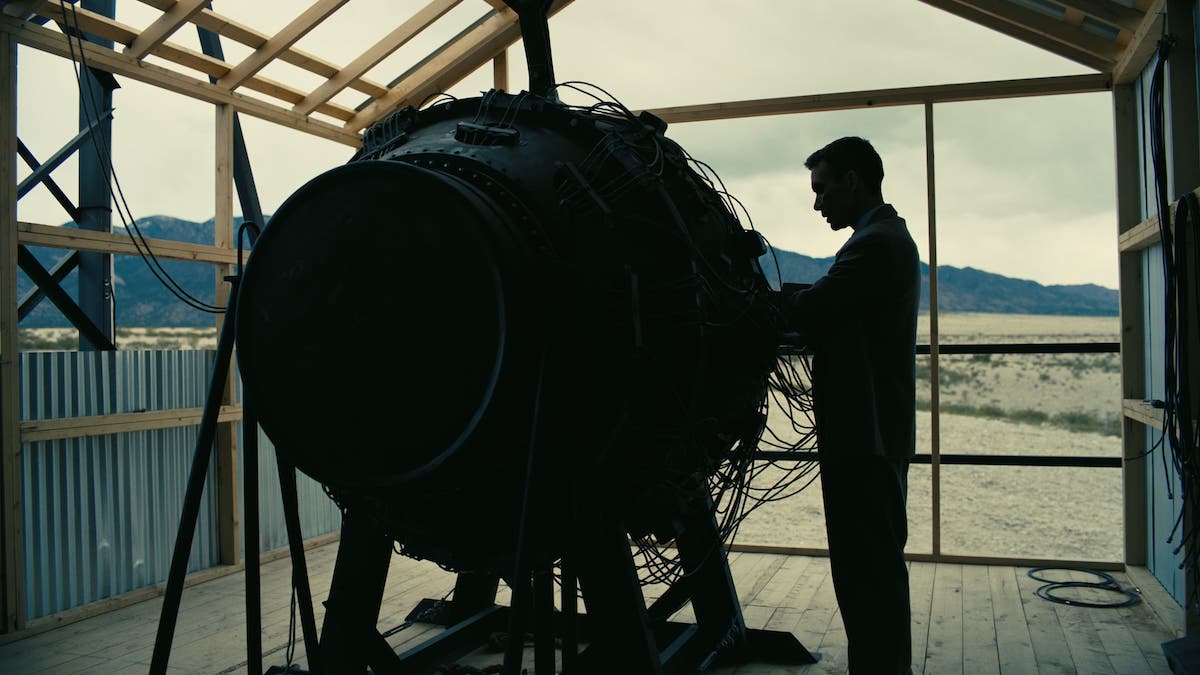
Other screen versions of Oppenheimer are largely forgotten, and mostly hard to find these days. Jeffrey DeMunn played him in the TV drama Hiroshima (1995), directed by Koreyoshi Kurahara and Roger Spottiswoode for Showtime; for the CBS Day One, David Strathairn took the role; in the fictional 2014-15 WGN series Manhattan, Daniel London played the relatively minor part of Oppenheimer and Groves is nowhere to be seen; and in the BBC’s 1980 series Oppenheimer, Sam Waterston was visually as well-cast as Murphy is in Nolan’s movie. (Unusually, this version gives much attention to the issue of his suspected communist affiliations and the security clearance hearings rather than focusing solely on Los Alamos.) Many of the real figures involved in the Manhattan Project also appear in the Oscar-nominated 1980 documentary The Day After Trinity.
For all its problems, Nolan’s Oppenheimer undoubtedly tackles its subject more stylishly than any of its predecessors, and if it doesn’t cast as much accurate light on the man as the more enthusiastic reviews have assumed, the same criticism could be levelled at most of the others (the 1980 BBC series is maybe the exception). And it is an interesting addition to Nolan’s filmography, too. As here, he often innovates within an essentially straightforward genre (rather than completely breaking out of genre), and while he’s not generally associated with factual stories, his Dunkirk (2017) and unproduced Howard Hughes biopic both dealt with roughly the same era as Oppenheimer. The new film does, in fact, have several elements that recall Dunkirk—the visceral physicality (less dominant here but as effective when it occurs), the use of music, and the ensemble cast, although Dunkirk didn’t try to balance a single protagonist and an ensemble the way that Oppenheimer unsuccessfully strives to.
The new film recalls Tenet, too, with the bomb almost resembling Tenet’s Algorithm device. Nolan is well aware of “the responsibilities for scientists developing new technologies that may have unintended consequences” and the difficulty of putting genies back into bottles, an issue that has arisen again in recent months with artificial intelligence.
There are also common wider Nolan themes, seen in many of his films, that recur here. There are contradictions—for example, that the bomb will both end the war and endanger the future, that the scientists’ work is so theoretical and yet has so much impact on people’s real lives. There is disorientation (Oppenheimer seems bemused by the vehemence directed at him by the security clearance hearing, as does Strauss at the result of his own Senate confirmation hearing). And, naturally, there are big ideas.
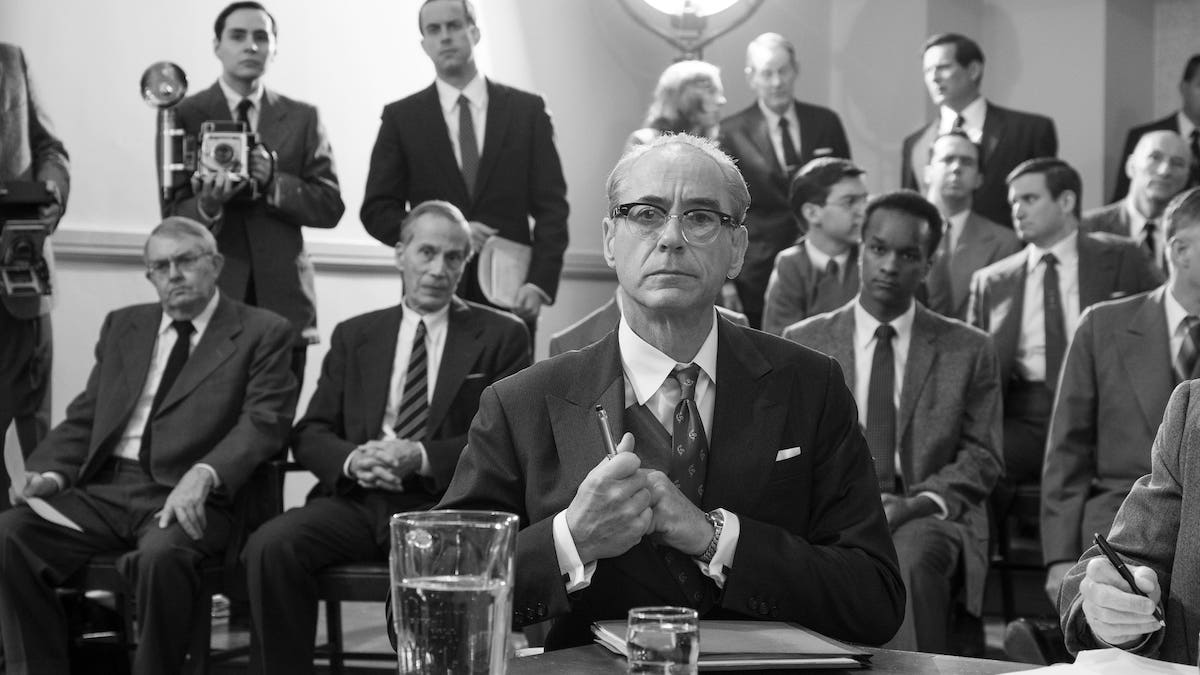
Nolan has never been afraid to tackle them; in fact, one of the most common criticisms of his work is that the concepts can take priority over storytelling. In Oppenheimer, that’s not the issue. It certainly feels a little over-long but it’s not lacking in narrative tension, though it is a problem that the post-Manhattan Project story really doesn’t have the mythic resonance of the bomb story, for all that Oppenheimer’s advocates try to invest it with such qualities. Nor does it feel lacking in humanity, thanks to the superb cast. Nor are the historical inaccuracies in themselves a problem.
The problem is, simply, that Oppenheimer promises to be insightful on the man and the issues, but isn’t on either. It tells too much story to really concentrate on Oppenheimer, it concentrates on Oppenheimer too much to really tell the historical story.
Tom Shone, whose 2020 book The Nolan Variations: The Movies, Mysteries, and Marvels of Christopher Nolan is surely one of the best ever written on a director whose career is still underway and who hasn’t entered the canon, writes that Nolan’s films are “easy to enter [but] fiendishly difficult to exit, ramifying endlessly in your head afterwards.” That’s true with Oppenheimer, but maybe not in the good way that Shone is implying.
For sure, J. Robert Oppenheimer was always destined to remain a bigger enigma than Barbie. But Nolan’s film does less to change that than it aspires to; not only is it more about raising questions than giving answers, it doesn’t even make clear what the questions about Oppenheimer should be, and at the same time it devotes a lot of energy to other characters and events which ultimately have little bearing on its subject (and are not in themselves interesting enigmas, either). It’s a powerful, well-crafted and terrifically well-acted film on a scene-to-scene basis, but in attempting to cover both the man and the history, it ends up satisfying on neither.
USA • UK | 2023 | 180 MINUTES | 1.43:1 • 2.39:1 | COLOUR • BLACK & WHITE | ENGLISH

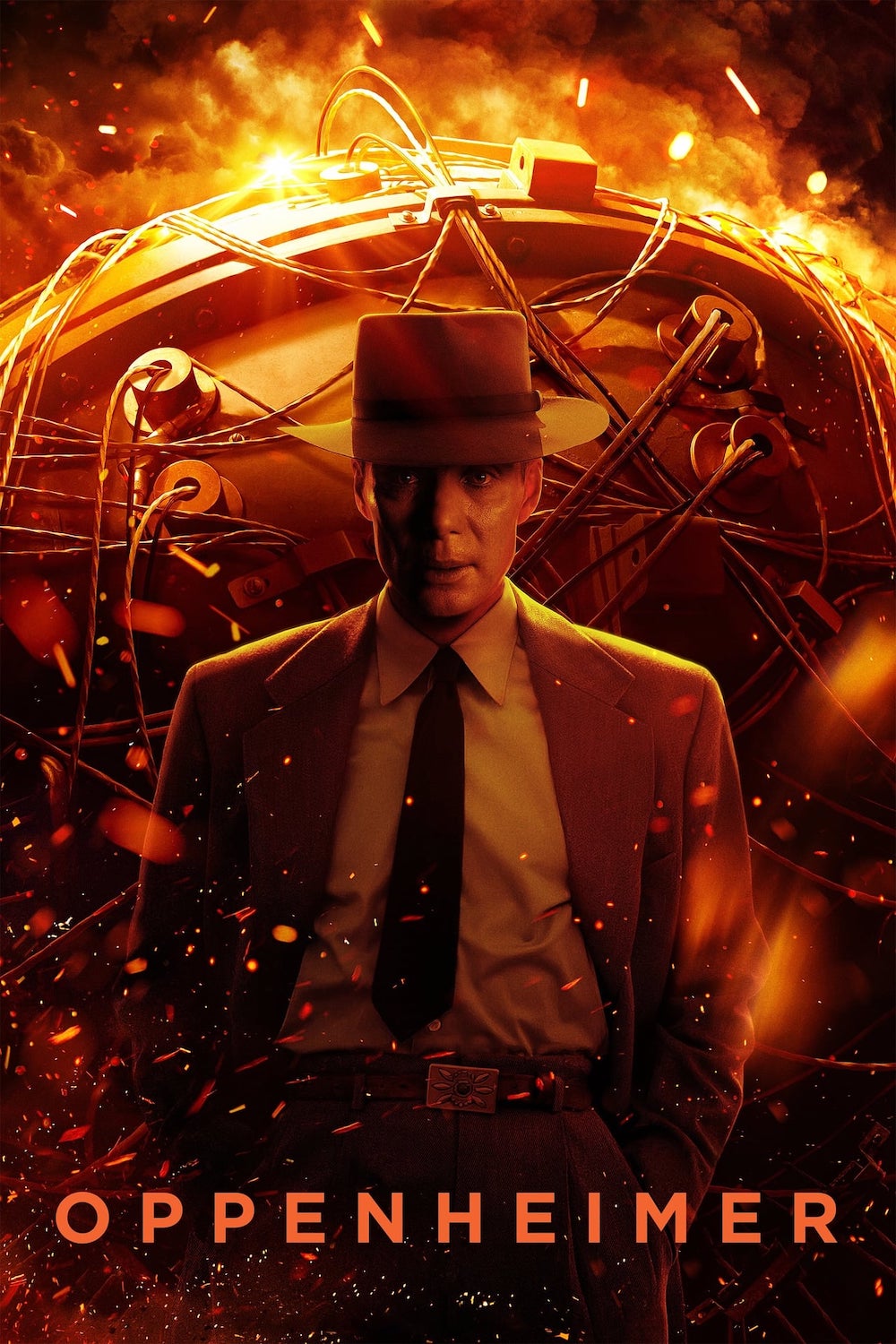
director: Christopher Nolan.
writer: Christopher Nolan (based on the book ‘American Prometheus’ by Kai Bird & Martin J. Sherwin).
starring: Cillian Murphy, Emily Blunt, Matt Damon, Robert Downey Jr., Florence Pugh, Josh Hartnett, Casey Affleck, Rami Malek, Kenneth Branagh, Benny Safdie, Jason Clarke, Tom Conti, Matthew Modine & Gary Oldman.
